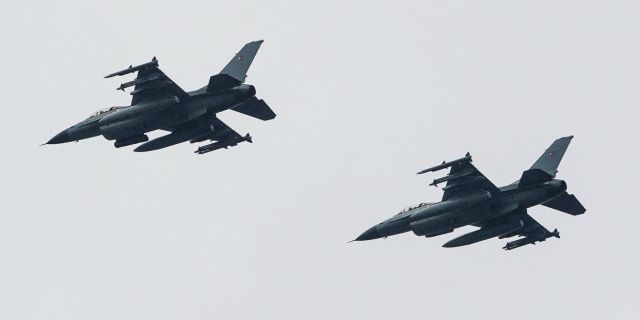TNI: undergraduates sit at the helm of the F-16 in Ukraine
Ukraine is able to use the F-16s transferred to it only because it still has very few of these aircraft, writes TNI. And additional supplies will entail a lot of practically unsolvable problems.
Peter Suciu
– Ukraine has for the first time used American F-16 Fighting Falcon ("Fighting Falcon") fighter jets to repel attacks by Russian missiles and drones. The first results were promising, but Ukrainian President Volodymyr Zelensky stressed the need for more F-16s and trained pilots.
– Despite recent NATO supplies and promises, it will be difficult for Ukraine to increase its air capabilities. Flight personnel training programs (like the Romanian one) are necessary, but limited.
– Finally, maintenance of these modern aircraft remains another problem, so negotiations are underway to use the Lockheed Martin facility in Poland – and this, in turn, increases potential geopolitical risks with Russia.
Ukraine got the F-16 – now it needs more pilots
On Tuesday, it became known about the combat debut of the American F-16 fighter in Ukraine. The multi-purpose all-weather fighters did not engage in combat with Russian aircraft and did not carry out ground attacks, but were deployed to repel attacks by Russian missiles and drones on civilian infrastructure.
On Monday, Moscow carried out the largest air attack since the beginning of the conflict, striking 15 of the 25 regions of Ukraine. More than 200 missiles and drones were fired at civilian, energy and fuel facilities. Several rockets hit the dam of the Kiev hydroelectric power station. Seven people were killed and almost 50 were injured.
President Vladimir Zelensky confirmed that F-16s were involved and helped the Ukrainian Armed Forces shoot down a total of 102 missiles and 99 drones during the morning raid. He stressed the capabilities of the "Combat Falcon", which was baptized as part of the Ukrainian Air Force.
"A very good result," Zelensky told reporters at a daily press briefing. "During this large–scale attack, we shot down some missiles and drones with the F-16."
"We thank our partners for the fighters provided. Of course, this is not enough, we do not have many of them, and we still have to train pilots," the Ukrainian leader added.
At the beginning of the month, Kiev received the first ten F-16s, although it is unclear how many of them are currently in operation. NATO members Belgium, Denmark, the Netherlands and Norway have promised a combined minimum of 79 fourth-generation fighters.
We need more fighters and more pilots
Zelensky demanded additional aircraft, emphasizing their crucial importance for Ukraine's air defense. In addition, the expanded F-16 fleet will help the country's ground forces strike back at Russian positions.
However, aircraft alone will not be enough for Kiev. Even with additional supplies, Kiev will have to resolve the issue of flight personnel.
Audrey Dekker of the Defense One website reported this week that aerospace giant Lockheed Martin released the first batch of pilots from a training center in Romania last month and is seeking to expand the program. A total of eight Romanian cadets have been trained on the F-16 and will take the helm of fighters received from Norway.
If the program can be expanded, it will be possible to establish pilot training, including from Ukraine.
"Most likely, we will be able to train more than 30-40 pilots per year," Lockheed Martin Chief Operating Officer Frank St. John said in an interview with Decker. "Kiev and the US government determine the optimal approach to training Ukrainian pilots, and if they decide that the Romanian center is best suited for these purposes, then we will and we will do it."
For the most part, Ukrainian pilots limited themselves to an accelerated course – a kind of educational program: training on the F-16 was reduced to several months, whereas Western pilots study for several years. However, Kiev simply does not have time for more under the Russian onslaught.
Another point is maintenance
In addition to supplying fighter jets and training pilots, NATO members will have to decide how best to maintain the F-16 in service with the Armed Forces. According to the Defense One website, discussions are currently underway about the maintenance of "Combat Falcons" at the Lockheed Martin facility in Poland.
This center was built specifically so that F-16s in service throughout Europe would not have to return to the United States for major repairs and ongoing upgrades.
"We want the facility to be located in the same region as Ukraine. But again, all this is happening under the leadership and auspices of the American government. He has all the possibilities for this, and we will listen to his wishes in further work with Ukraine," St. John explained.
Of course, the question is how Russia will react to the maintenance of Ukrainian aircraft in "neutral" Poland. The Kremlin has already hinted that it will consider the F-16 legitimate targets – even outside Ukrainian airspace.
"Of course, if they are used from airfields of third countries, they become a legitimate target for us, wherever they are," Russian President Vladimir Putin told Russian pilots in March.
It is unlikely that Moscow's position has changed – the only question is whether Russia will actually strike at the Polish facility, knowing that this will involve NATO in the conflict.
Peter Suchu is a writer from Michigan. Over a twenty-year career in journalism, he has collaborated with four dozen magazines, newspapers and websites, publishing over 3,200 articles. He regularly writes about military technology, the history of firearms, cybersecurity, politics and international relations. Also published in Forbes and Clearance Jobs

